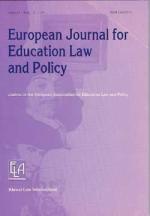Governance through checks and balances
An approach to drafting regulations for higher education and research
 European Journal for Education Law and Policy 1: 57-80, 1997.
European Journal for Education Law and Policy 1: 57-80, 1997.
© 1997 Kluwer Law International. Printed in the Netherlands.
“If you.. give.. too high authority to a soul that does not measure up to it, the result is always disastrous. Body and soul become puffed up: disease breaks out in the one, and in the other arrogance quickly leads to injustice.” The Athenian (Plato, The Laws)
1.1 Preview
The art of transforming the very advanced new steering
philosophies and models, and new ideas on how to govern higher education,
into effective juridical language, is at an early stage. The jurists follow
the model makers at a respectful distance. This contribution to the debate
on how to combine democratic governance of higher education and research
systems with efficient management, is in the first place meant to give
guidance to the practice of drafting rules and regulations and to reduce
sub-optimal decision making. It is also an attempt to explore denominators
for further multi disciplinary and comparative research.
After introducing a juridical perspective to the subject and changes of
political direction in 1.2, I will define democracy, governance and management
for the purpose of this essay in 1.3. In 2.1 and 2.2, the focus is on
the position and limits of government and steering models. The possibilities
of and need for a juridical model are explored in 2.3. In 3.1-3.7, taking
a general approach to public administration, I will outline characteristics
of education and research systems which are relevant for juridical practice.
In 4, public and private are taken together in one legal system. Juridical
instruments, particularly rules, regulations and agreements, are examined
in the light of managerial processes. In 5, features of a juridical approach
to regulating governance through checks and balances, are based more on
a contract-oriented approach, and less on regulating. 5.4 and 5.5 are
the beginnings of a shadow-model for draftsmen of regulations that could
improve the ability of systems and institutions to respond to change.
1.2 Change and models in a juridical perspective
1. 2. 1 Democracy and governance
Higher education is the conscience of society, the school
for future leadership of private business and public bodies, an engine
of the economy, and a main motor of technological progress, to name a
few claims for it. Higher education institutions should provide the best
examples of good practice to society, also in the form of their own performance.
They are already relatively well governed, at least not less so than other
organisations. Interesting experiments took place in the past, and once
again higher education governance is subject to massive revision. Governance
is not the goal, but a logistic service to the core business of higher
education institutions: innovation through transfer and development of
knowledge. These are challenges that should lead to profound consequences
for higher education regulation, and maybe also beyond: for governance
in general.
Legal checks and balances can create, maintain or destroy a fruitful balance
of power. The process of regulating democratic governance is aimed at
preventing undue accumulation of power in the State, any organisation
or person. Checks and balances as such do not have negative effects for
efficiency and effectiveness, and have positive effects on the core business.
Every section in a law or by-law should be assessed according to how it
contributes to this.
Governance of higher education and research takes place at multiple levels:
State, intermediaries and institutions. Each of them has various layers.
This makes it difficult to match democratic and decentralised governance
with effectiveness and efficiency, without losing a view to the primary
processes. In practice, these objectives are sometimes considered incompatible,
resulting in the temporary dominance of one. Democratic governance of
higher education is, in the light of its position in society and the legal
status of the institutions, an issue on the interface of the public and
private sector. This is a tough issue as the abundant literature indicates.
However, the list of publications on societal change with a balanced view
to public and private administration is not that long, and the adjective
'democratic' often underexposed.
1.2.2 Change of political direction
It is a widespread impression that national differences between policies and laws are rapidly disappearing. This impression may be partly due to international exchange and mobility, and vivid discussion on all sorts of issues in the literature and within international organisations, and seems valid for issues that are closely connected with mobility, such as recognition of titles and degrees. However, as a general conclusion it seems only partly true. At least eighteen unique national systems emerged. Albania appeared on the map. Three countries in central and eastern Europe disintegrated. The three Baltic countries, starting in 1990 from the same system of the former Soviet Union, have now drifted apart from Russia which is going its own way. This process is continuing, although 'the western European higher education system' guides Lithuania, Latvia as well as Estonia. The same can be said of Moldova, Ukraine and Belarus and the three Caucasian Republics; the Czech and Slovak Republics; Slovenia, Croatia, Bosnia & Herzegovina, Serbia and the Former Yugoslav Republic of Macedonia.
| Naar publicatielijst | 1 2 3 4 ... 17 - Next | Naar boven |
